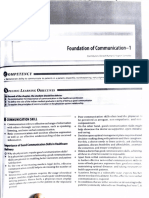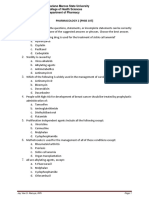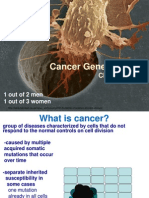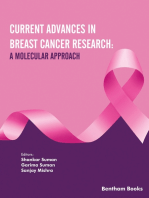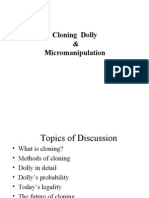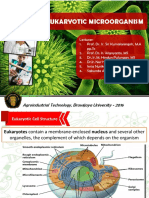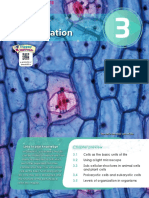Primary Syphilis
Primary Syphilis
Uploaded by
Eqah TajuddinCopyright:
Available Formats
Primary Syphilis
Primary Syphilis
Uploaded by
Eqah TajuddinOriginal Description:
Original Title
Copyright
Available Formats
Share this document
Did you find this document useful?
Is this content inappropriate?
Copyright:
Available Formats
Primary Syphilis
Primary Syphilis
Uploaded by
Eqah TajuddinCopyright:
Available Formats
SYPHILIS
Definition
Chronic systemic infection caused by Treponema pallidum, is usually sexually
transmitted and is characterized by episodes of active disease interrupted by
periods of latency
Disease with local and systemic manifestations
Syphilis becomes a systemic disease shortly after infection & can be transmitted
from a pregnant woman to her fetus as early as the 9 th week of gestation
Epidemiology
In 2010, the rate of syphilis infection was 7.9 cases per 100,000 populations for men
& 1.1 cases per 100,000 for women.
Rate of primary & secondary syphilis has risen dramatically among men driven by
increased transmission of syphilis among men who have sex with men (MSM),
During pregnancy, untreated early syphilis results in perinatal death in as many as
40% of cases & may lead to fetal infection in more than 70% of cases
Worldwide, there are estimated to be 1.4 million cases of syphilis among pregnant
women, with 500,000 adverse pregnancy outcomes annually
Staging
1. Primary syphilis
Begins at the site of bacterial invasion, where T. pallidum multiplies in the
epithelium & produces a granulomatous tissue reaction called a chancre
Some microorganisms drain with lymph into adjacent lymph nodes. Within the
nodes and at the site of the chancre, the cell-mediated & humoral immune
responses are stimulated
2. Secondary syphilis
Systemic & bacteria spread to all major organ systems
It is followed by a period during which the immune system is able to suppress the
infection
Even without treatment, spontaneous resolution of the skin lesions occurs & the
individual enters the latent stage of infection
3. Latent syphilis
May be subdivided into early & late stages, however, no specific criteria delineate
one from the other
Medical history & serologic studies show that syphilis is present, but individual has
no clinical manifestations
Transmission is possible during the late & early latent stages
4. Tertiary syphilis
Most severe stage, involving significant morbidity and mortality
The destructive skin, bone & soft tissue lesions (called gummas) of tertiary syphilis
probably are caused by a severe hypersensitivity reaction to the microorganism.
CVS: may cause aneurysms, heart valve insufficiencies & heart failure
CNS: presence in CSF may cause the manifestations of neurosyphilis, which can
occur within any stage of syphilis infection
Microbiology Treponema Pallidum
i. Morphology & identification
Organism:
Slender spirals measuring 0.2 m (width) & 5 15 m (length)
Corkscrew like motility, rotating around their endoflagella
Microaerophilic, survives best at 3 5 % oxygen
Seen with immunofluorescent stain or dark field microscope
Culture:
Pathogenic T. pallidum has never been cultured on media, eggs or tissue
Non pathogenic can be cultured anaerobically in vitro
ii. Antigenic structure
Outer membrane surround the periplasmic space & peptidoglycan cytoplasmic
membrane complex
Membrane proteins are present that contain covalently bound lipid at amino
terminal anchor the proteins to cytoplasmic or outer membrane proteins
inaccessible to antibodies
Endoflagella in periplasmic space
Hyaluronidase invasiveness
Lipoproteins induce inflammation tissue destruction
iii. Pathogenesis
T. pallidum penetrate intact mucous membrane OR through break in epidermis
1 & 2 lesion rich in spirochetes & highly infectious but, 3 treponemas
are very rare
Progression:
30% early syphilitic infection progresses spontaneously to complete cure
without treatment
30% the untreated infection remains latent
Remainder progresses to the 3 characterized by the development of
granulomatous lesions (gummas), degenerative changes in CNS or CVS
Multiply locally at site of entry
Some spread to nearby lymph nodes & reach blood stream
2 10 weeks papule develops at site of infection
Papule breaks down forming ulcer with clean, hard base/chancre, painless (1 lesion)
2 10 weeks later red maculopapular rash anywhere on body & moist, pale papules in
anogenital region, axilla & mouth (2 lesion)
Symptoms of 2 lesion will go away with or without treatment & enter latent stage (no
symptoms)
After 3 5 years contagious lesion may recur & not infectious except for mother to fetal
transmission
May progress to 3 stage (RARE)
Gumma: form of progressive inflammation that appear as rubbery masses of tissue
in various organ after about 15 years
CVS: weakening of aorta
Neurosyphilis: dementia, seizure, loss coordination of voluntary movement, sight or
hearing loss
You might also like
- The Art and Science of Thread Lifting: Based on Pinch AnatomyFrom EverandThe Art and Science of Thread Lifting: Based on Pinch AnatomyNo ratings yet
- CH 30 Earthworm Label Color and QuestionsDocument4 pagesCH 30 Earthworm Label Color and Questionsapi-444439435No ratings yet
- Shadowing DoctorsDocument2 pagesShadowing DoctorsJDNo ratings yet
- DAMS CRS Medicine (DAMS Faculty) (Z-Library)Document680 pagesDAMS CRS Medicine (DAMS Faculty) (Z-Library)StarNo ratings yet
- (Ebooks PDF) Download Complications of Urologic Surgery Prevention and Management 4th Edition Samir S. Taneja Full ChaptersDocument84 pages(Ebooks PDF) Download Complications of Urologic Surgery Prevention and Management 4th Edition Samir S. Taneja Full Chaptersvalovpashay100% (4)
- Study Problems of Medical StudentsDocument51 pagesStudy Problems of Medical StudentsSk PraveinNo ratings yet
- What Is Part Period Interest in Sbi Education Loan - Brainly - inDocument1 pageWhat Is Part Period Interest in Sbi Education Loan - Brainly - inHimanshu ChandrawalNo ratings yet
- Malignant Vs Traumatic Tongue Ulcer A Clinical AppDocument6 pagesMalignant Vs Traumatic Tongue Ulcer A Clinical Appvivi hutabaratNo ratings yet
- Infertility - الدوائيةDocument95 pagesInfertility - الدوائيةشعاع قحطانNo ratings yet
- Urology For Undergraduate 2021Document91 pagesUrology For Undergraduate 2021mzucc109No ratings yet
- Department of Histopathology: Appendix: - Acute Appendicitis With PeriappendicitisDocument1 pageDepartment of Histopathology: Appendix: - Acute Appendicitis With PeriappendicitisMuhammad RizwanNo ratings yet
- Introduction To History Taking & Physical Examination in SurgeryDocument46 pagesIntroduction To History Taking & Physical Examination in Surgerychimeremeze.ukonye.244249No ratings yet
- GP1 Introduction To PathologyDocument74 pagesGP1 Introduction To PathologyAh ZhangNo ratings yet
- Aetcom NDDocument7 pagesAetcom NDbansiwalchanchal220100% (1)
- Ophthalmology VIBEDocument78 pagesOphthalmology VIBEDinesh JadhavNo ratings yet
- 11 Reproductive System PhysiologyDocument38 pages11 Reproductive System PhysiologyKaye Alyssa EnriquezNo ratings yet
- FRCPath Part 1 Course - Day 1Document11 pagesFRCPath Part 1 Course - Day 1Marvi UmairNo ratings yet
- 6) StatisticsDocument17 pages6) StatisticsAhmed Tawfig GamalNo ratings yet
- Benign Tumor Malignant Tumor: Ms. Sneha Sehrawat AIIMS RishikeshDocument37 pagesBenign Tumor Malignant Tumor: Ms. Sneha Sehrawat AIIMS RishikeshRajaNo ratings yet
- NEET PG Exam SyllabusDocument2 pagesNEET PG Exam SyllabusRoopakNo ratings yet
- CP Baveja Textbook of MicrobiologyDocument20 pagesCP Baveja Textbook of MicrobiologySaima khanamNo ratings yet
- Get Breast Pathology 2nd Edition David J Dabbs Free All ChaptersDocument64 pagesGet Breast Pathology 2nd Edition David J Dabbs Free All Chaptersmullalipp100% (4)
- Medicine Simplified DBMCI: To Get More Content Like This Join Our Telegram GroupDocument8 pagesMedicine Simplified DBMCI: To Get More Content Like This Join Our Telegram GroupAnisa Osman HassanNo ratings yet
- Personalized Medicine Universe: Jack Kushner, MD, MGA, FACS, FICS, FAANS, HDGDocument4 pagesPersonalized Medicine Universe: Jack Kushner, MD, MGA, FACS, FICS, FAANS, HDGvara prasadNo ratings yet
- History Taking2Document25 pagesHistory Taking2Capture UnseenNo ratings yet
- Pharmacology 2 Long Exam Oncology-NkDocument7 pagesPharmacology 2 Long Exam Oncology-NkT'amo HanashNo ratings yet
- Second MBBS Microbiology SyllabusDocument29 pagesSecond MBBS Microbiology SyllabusUday KolheNo ratings yet
- PDF 100 Cases Histories in Clinical Medicine for MRCP Part 1 2004 1/E Edition Farrukh Iqbal downloadDocument85 pagesPDF 100 Cases Histories in Clinical Medicine for MRCP Part 1 2004 1/E Edition Farrukh Iqbal downloadminiomcrljic100% (6)
- AAES Guidelines Thyroid PDFDocument73 pagesAAES Guidelines Thyroid PDFDana ChernovNo ratings yet
- Responsible Use of Medicines Handbook - IPA PDFDocument110 pagesResponsible Use of Medicines Handbook - IPA PDFRamaNo ratings yet
- Pathology (1,2,3) - AFR DesktopDocument56 pagesPathology (1,2,3) - AFR DesktopNAYEEMA JAMEEL ANUVANo ratings yet
- Bio StatisticsDocument115 pagesBio Statisticspallabisarkar25No ratings yet
- Hematological Disorders in Geriatric PatientsDocument18 pagesHematological Disorders in Geriatric PatientsAndre HawkNo ratings yet
- Male Factor InfertilityDocument53 pagesMale Factor InfertilityMarcel MusteaNo ratings yet
- Pathology Questions PDFDocument67 pagesPathology Questions PDFDhruva PatelNo ratings yet
- NEET PG 2014 Question Paper With SolutionsDocument2,472 pagesNEET PG 2014 Question Paper With SolutionsmedpoxNo ratings yet
- UTIDocument17 pagesUTIBongkotchakorn Mind PhonchaiNo ratings yet
- PDF Oxford Handbook of Clinical Pathology James Carton DownloadDocument44 pagesPDF Oxford Handbook of Clinical Pathology James Carton Downloadbezeyiamefia81100% (6)
- Past Q KusmsDocument10 pagesPast Q Kusmspriya jha100% (1)
- Embryology of Salivary GlandsDocument21 pagesEmbryology of Salivary GlandsMuhammad Ihsan SiregarNo ratings yet
- Warfarin CounsellingDocument2 pagesWarfarin CounsellingAnonymous 9dVZCnTXSNo ratings yet
- AMYLOIDOSISDocument3 pagesAMYLOIDOSISHenry KaweesaNo ratings yet
- 6th Lecture Embryogenesis 2nd Week-8thDocument28 pages6th Lecture Embryogenesis 2nd Week-8thHussein Al Saedi100% (1)
- 10 Departmental Library PDFDocument10 pages10 Departmental Library PDFraveenkumarNo ratings yet
- Romanowky StainsDocument45 pagesRomanowky StainsFinu FarisaNo ratings yet
- Placenta and Trophoblast - Methods and Protocols (Vol 1) - M. Soares, J. Hunt (Humana, 2006) WW PDFDocument490 pagesPlacenta and Trophoblast - Methods and Protocols (Vol 1) - M. Soares, J. Hunt (Humana, 2006) WW PDFAlexandra IoanaNo ratings yet
- Postgraduate Manual of Pathology 6th Ed. 2023-Dr. Shiva MDDocument97 pagesPostgraduate Manual of Pathology 6th Ed. 2023-Dr. Shiva MDYogita BhansaliNo ratings yet
- Clinical Pearls in Tremor and Other Hyperkinetic MovimentDocument7 pagesClinical Pearls in Tremor and Other Hyperkinetic Movimentrafael rocha novaesNo ratings yet
- NCCN Guidelines Prostate Cancer V3.2024Document221 pagesNCCN Guidelines Prostate Cancer V3.2024zdmoorNo ratings yet
- K - 8 Blood Brain Barrier (Biokimia)Document31 pagesK - 8 Blood Brain Barrier (Biokimia)Firman YunusNo ratings yet
- Cancer PPT On The BiologyDocument55 pagesCancer PPT On The Biologyjohnbharot91No ratings yet
- Safety Data GenerationDocument55 pagesSafety Data GenerationBhavadharani RNo ratings yet
- GCP Flash CardDocument3 pagesGCP Flash CardSok Yee100% (1)
- Clinical PharmacokineticsDocument1,135 pagesClinical PharmacokineticstayhodgesNo ratings yet
- Pathology -Dr.Priyanka Sachdev - (17 Oct 23)Document188 pagesPathology -Dr.Priyanka Sachdev - (17 Oct 23)aayushmanm5No ratings yet
- Lec - 9 Concept of Angiogenesis and Importance of Nutraceuticals in Health PromotionDocument18 pagesLec - 9 Concept of Angiogenesis and Importance of Nutraceuticals in Health PromotionDivya DiyaNo ratings yet
- 4 I Morpho - Reversible Cell InjuryDocument21 pages4 I Morpho - Reversible Cell InjuryKartikey MishraNo ratings yet
- STAGING QS BY DR SalmanDocument18 pagesSTAGING QS BY DR SalmanKahkashan Hameed100% (1)
- The CervixFrom EverandThe CervixJoseph JordanNo ratings yet
- Diagnostics to Pathogenomics of Sexually Transmitted InfectionsFrom EverandDiagnostics to Pathogenomics of Sexually Transmitted InfectionsSunit Kumar SinghNo ratings yet
- Current Advances in Breast Cancer Research: A Molecular ApproachFrom EverandCurrent Advances in Breast Cancer Research: A Molecular ApproachNo ratings yet
- Regulation of Gene ExpressionDocument18 pagesRegulation of Gene Expressionchocoholic potchiNo ratings yet
- Biology Exam 2 Notes - CWRU!!!Document11 pagesBiology Exam 2 Notes - CWRU!!!sxh580No ratings yet
- NiptDocument11 pagesNiptapi-317795854No ratings yet
- STM 008 Biology 2Document4 pagesSTM 008 Biology 2Jv BiasuraNo ratings yet
- Rooted Vs Unrooted TreeDocument4 pagesRooted Vs Unrooted TreeMehwsihNo ratings yet
- ECOSYSTEMDocument17 pagesECOSYSTEMprajwalvyadavNo ratings yet
- Instituto Politécnico Nacional: Centro de Estudios Científicos y Tecnológicos No. 16 "Hidalgo"Document25 pagesInstituto Politécnico Nacional: Centro de Estudios Científicos y Tecnológicos No. 16 "Hidalgo"JorgeNo ratings yet
- Chem 464 Biochemistry: Multiple Choice (4 Points Apiece)Document4 pagesChem 464 Biochemistry: Multiple Choice (4 Points Apiece)AbshirNo ratings yet
- Seed Plants Lab: Learning ObjectivesDocument11 pagesSeed Plants Lab: Learning Objectivesapi-232487761No ratings yet
- Bhunia y Ray 2013 Introduction To Food MicrobiologyDocument8 pagesBhunia y Ray 2013 Introduction To Food MicrobiologyWendy KatherineNo ratings yet
- Questions Chapter 1 Competancy Based XII BiologyDocument11 pagesQuestions Chapter 1 Competancy Based XII Biologyakab1042007No ratings yet
- Ion Transport ProblemsDocument3 pagesIon Transport ProblemsTawanda CharumukaNo ratings yet
- Ncert Line by Line ZoologyDocument16 pagesNcert Line by Line Zoologyravillamuni007No ratings yet
- Antifungal Drugs: DR Muhammad Sadiq GulDocument23 pagesAntifungal Drugs: DR Muhammad Sadiq GulHasan AnsariNo ratings yet
- The Natural History of Infection: M. R. BarerDocument6 pagesThe Natural History of Infection: M. R. Barernour achkarNo ratings yet
- 2nd - Sem - BPharma - Nucleic Acid NotesDocument55 pages2nd - Sem - BPharma - Nucleic Acid NotesDeep MaliNo ratings yet
- 1516 MY F3 Bio Marking PDFDocument2 pages1516 MY F3 Bio Marking PDFchemNo ratings yet
- BSc-Botany-Hon-CBCS (2020)Document92 pagesBSc-Botany-Hon-CBCS (2020)Music LoverNo ratings yet
- Projek Jawab Untuk Jaya 2010 BiologyDocument207 pagesProjek Jawab Untuk Jaya 2010 BiologywhywhyqNo ratings yet
- AshleighKWolfe CVDocument4 pagesAshleighKWolfe CVAshNo ratings yet
- bbc115 Slide Intercellular CommunicationDocument26 pagesbbc115 Slide Intercellular CommunicationPriawanIndraNo ratings yet
- Cloning Dolly & MicromanipulationDocument29 pagesCloning Dolly & Micromanipulationnitinyadav16No ratings yet
- Eukaryotic MicroorganismDocument21 pagesEukaryotic MicroorganismEdie SilvergunsNo ratings yet
- Metabolism: Written by TutorDocument4 pagesMetabolism: Written by TutorRyan Carlo CondeNo ratings yet
- Blotting TechniqueDocument5 pagesBlotting Techniqueporkodi sudhaNo ratings yet
- Bacterial Transformation: 1-Calcium Ion TreatmentDocument3 pagesBacterial Transformation: 1-Calcium Ion TreatmentE MeerNo ratings yet
- Chapter 3 (For Chapter 2 LG) ReferenceDocument44 pagesChapter 3 (For Chapter 2 LG) ReferenceMi KaNo ratings yet
- Genetically Modified OrganismDocument21 pagesGenetically Modified OrganismJayson ArsenioNo ratings yet
- Regenerative Medicine From Protocol To PatientDocument257 pagesRegenerative Medicine From Protocol To PatientMandraludin0% (1)













